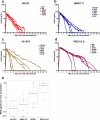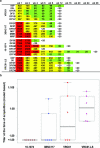A single injection of anti-HIV-1 antibodies protects against repeated SHIV challenges
- PMID: 27120156
- PMCID: PMC5127204
- DOI: 10.1038/nature17677
A single injection of anti-HIV-1 antibodies protects against repeated SHIV challenges
Abstract
Despite the success of potent anti-retroviral drugs in controlling human immunodeficiency virus type 1 (HIV-1) infection, little progress has been made in generating an effective HIV-1 vaccine. Although passive transfer of anti-HIV-1 broadly neutralizing antibodies can protect mice or macaques against a single high-dose challenge with HIV or simian/human (SIV/HIV) chimaeric viruses (SHIVs) respectively, the long-term efficacy of a passive antibody transfer approach for HIV-1 has not been examined. Here we show, on the basis of the relatively long-term protection conferred by hepatitis A immune globulin, the efficacy of a single injection (20 mg kg(-1)) of four anti-HIV-1-neutralizing monoclonal antibodies (VRC01, VRC01-LS, 3BNC117, and 10-1074 (refs 9 - 12)) in blocking repeated weekly low-dose virus challenges of the clade B SHIVAD8. Compared with control animals, which required two to six challenges (median = 3) for infection, a single broadly neutralizing antibody infusion prevented virus acquisition for up to 23 weekly challenges. This effect depended on antibody potency and half-life. The highest levels of plasma-neutralizing activity and, correspondingly, the longest protection were found in monkeys administered the more potent antibodies 3BNC117 and 10-1074 (median = 13 and 12.5 weeks, respectively). VRC01, which showed lower plasma-neutralizing activity, protected for a shorter time (median = 8 weeks). The introduction of a mutation that extends antibody half-life into the crystallizable fragment (Fc) domain of VRC01 increased median protection from 8 to 14.5 weeks. If administered to populations at high risk of HIV-1 transmission, such an immunoprophylaxis regimen could have a major impact on virus transmission.
Figures







Comment in
-
Broadly Neutralizing Antibodies: Magic Bullets against HIV?Immunity. 2016 Jun 21;44(6):1253-4. doi: 10.1016/j.immuni.2016.06.012. Immunity. 2016. PMID: 27332729
-
Recent progress in anti-HIV broadly neutralizing antibody research.AIDS. 2017 Oct 23;31(16):N21. doi: 10.1097/QAD.0000000000001544. AIDS. 2017. PMID: 28514282 No abstract available.
References
-
- Baba TW, et al. Human neutralizing monoclonal antibodies of the IgG1 subtype protect against mucosal simian-human immunodeficiency virus infection. Nat Med. 2000;6:200–206. doi:10.1038/72309. - PubMed
-
- Mascola JR, et al. Protection of macaques against vaginal transmission of a pathogenic HIV-1/SIV chimeric virus by passive infusion of neutralizing antibodies. Nat Med. 2000;6:207–210. doi:10.1038/72318. - PubMed

